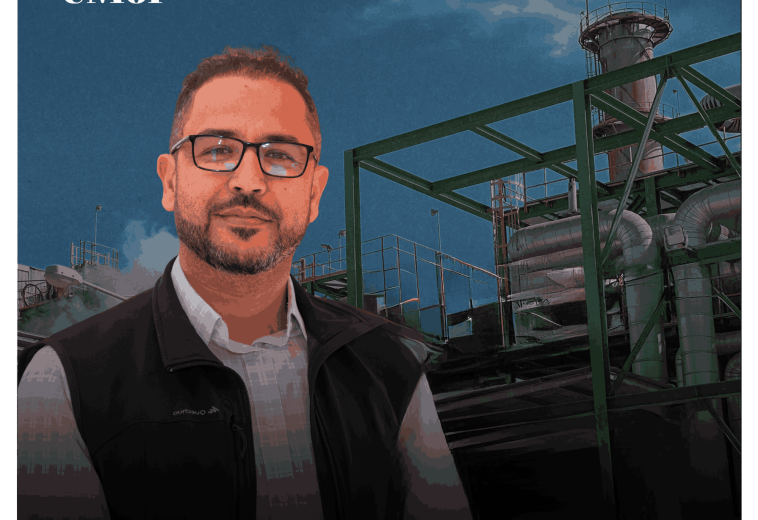When phosphate waste is converted into advanced materials
With Youssef Belmabkhout
Waste, including phosphogypsum, resulting from the industrial processing of phosphate, is rightly denounced for its negative impact on the environment, not to mention its bulkiness. Until then, they were considered an inevitable inevitability. Researchers at UM6P have found ways to recycle this waste into a profitable industrial resource. A great step forward for the circular economy and materials science.
A team of scientists from UM6P has achieved an important scientific breakthrough: transforming industrial phosphate waste into strategic porous materials. Mining waste and phosphogypsum, by-products long considered to be inevitable collateral damage to the environment, are transformed into high-performance solid materials with variable porosities. The change is not only technical. It is a new way of thinking about value and waste and an important contribution of Africa to science.
All over the world, phosphate-rich countries have faced the same dilemma: how to manage the massive tonnage of industrial by-products generated by phosphate processing?
In Morocco, where the phosphate industry is both the backbone and the pride of the national economy. But, it is important to know that 4 to 5 tons of phosphogypsum are generated for each ton of phosphoric acid produced. On a global scale, the phosphate industry produces an astronomical 150 to 200 million tons of phosphogypsum, which is stored in the form of huge hillfields when it is not discarded into the sea. These huge stocks pollute the land, waterways and sea.
Moroccan scientists have set themselves a challenge: how to transform this waste into a raw material for industry, into a specialty product. Their ambition is not to make a symbolic invention with no future, but to create a new industry through a rigorous scientific approach, using intelligent chemistry and system-level design.
This is precisely the feat achieved by the team led by Professor Youssef Belmabkhout and Dr. Ayalew Assen at the UM6P Research Center of Excellence in Applied Chemistry and Engineering (ACER CoE).
Their early work was to transform phosphogypsum – once a discarded by-product – into an advanced research object of materials science. To do this, they have changed the paradigm in our conception of industrial residues
Not through marginal gains, but by initiating a paradigm shift in the way we understand industrial waste, catalysis and circular value creation.
As part of a specific research path concerning phosphogypsum (PG), the ACER team has developed a sustainable process to convert PG into not one, but two classes of functional materials: zeolites and calcium-based metallo-organic frames (Ca-MOFs). These porous solids, which are at the heart of key industrial processes – from CO₂ capture to alcohol dehydration – could potentially be used for molecular sensing and catalytic transformations.
Production of advanced materials from waste
Phosphogypsum is a heavy responsibility. Morocco alone produces millions of tons of it per year, much of which is stored in huge open-air landfills. Its chemical profile, dominated by CaSO₄·2H₂O, also contains silica, alumina, calcium and also traces of dozens of other metals. It has long posed a delicate environmental problem.
“We don’t consider it,” explains Professor Belmabkhout, “as a waste product but as a set of elements on the periodic table: silica, alumina, calcium, etc. and also traces of dozens of other metals. »
The approach to this research is as ingenious as it is strategic and simple. PG is, first, dissolved in a mild alkaline solution. Silica and alumina are separated and used to synthesize a zeolite called cancrinite (CAN), while the calcium-rich residue is transformed into several forms of Ca-MOF.
Among the MOFs (Organo-Metallic Materials) synthesized are SBMOF-2, Ca-BDC and Ca-BTC, each with its own properties suitable for industrial use. For example, PG-derived cancrinite zeolites have shown excellent CO₂ capture performance, outperforming similar products obtained from commercial precursors. Even more striking, the Ca-BTC MOF was able to selectively sieve alcohol water molecules, an application with huge implications for bioethanol purification and industrial solvent recovery. This is only the tip of the iceberg, many applications remain to be explored.
“This ability to separate water and alcohol was not known in this context,” continues Professor Belmabkhout. And this comes from a material derived from waste and this is just the tip of the iceberg. That’s the beauty of it. »
A circular economy logic

Moroccan researchers transform phosphate rock by-products into industrial gold
To understand the stakes, let us ask the following: nearly half of the world’s industrial energy is consumed in the processes of separation and transformation of purification chemicals, hydrocarbon cracking and polymer production.
“Everything around you,” Belmabkhout emphasizes, is the result of separation and transformation. The purification of olefins for plastic production alone consumes 1% of the world’s energy. »
This is where porous materials come in. Zeolites and MOFs act as molecular sieves, separating compounds based on their size, polarity, or affinity.
They are essential in catalysts, membranes, and adsorption-based filters. But their widespread industrial use is often blocked by the high cost of their synthesis.
“You need materials with extremely controlled architectures,” says Assen. But synthesis often relies on expensive precursors, aggressive solvents and energy-intensive solutions. »
Using phosphogypsum as a precursor solves several problems at once: it is abundant, cheap, and chemically versatile. Most importantly, it anchors the production of high-tech materials in a circular economy logic that is both pragmatic on an industrial level and strategic on an environmental level.
A new kind of catalyst
The ACER team’s methodology opens up new avenues not only for materials science, but also for how we think about resource flows in the phosphate value chain. Traditionally, PG mining waste and other phosphates were excluded from the innovation loop. For example, PG is stored in piles and is only partially reused in agriculture or construction.
But as Professor Belmabkhout points out, even the beneficiation stage, the first filtration of phosphate ore, generates multiple layers of worthless “by-products”. “After enrichment,” he continues, “only particles smaller than 60 microns are sent to the production line. The rest – large particles, tails, non-compliant materials – remain in the mine, even though they are chemically rich. This idea echoes the logic of cutting-edge research in green chemistry: start with what is abundant, not what is pure. “Why not design advanced materials from impurities? This is where the real innovation lies. »
This philosophy also challenges conventional notions of supply chains in Africa. Rather than exporting raw materials and importing high-value components, this model builds technological sophistication directly on local raw inputs. Indeed, it short-circuits Africa’s global dependence loop.
The boundary between product and waste is disappearing
Although the research is still at the pilot stage, its implications are industrial. The process results in pure porous materials in phase with reproducible structures, verified by XRD, FTIR, SEM-EDX and gas adsorption measurements.
More importantly, the cost-benefit calculations are promising: based on mass balances and preliminary yield analysis, PG to zeolite and PG to MOF conversions are competitive with traditional methods.
“This work lays the groundwork for scale-up,” Belmabkhout says, not only in the labs, but potentially in modular units near mine sites. We could imagine integrated platforms that recover PG on site, thus converting environmental waste into exportable technological products. »
Beyond zeolites and Ca-MOFs, the UM6P research team is also studying the production of mesoporous silicate materials (MSMs), alumina, and silica-alumina phosphate materials using other phosphate byproducts.
In parallel, the team synthesized four classes of MSM from two types of phosphate mining waste, achieving lead removal capacities of more than 800 mg/g, comparable to those of the best materials in the scientific literature.
The lesson is clear: the old distinction between waste and product is disappearing. And the future of materials science may well be rooted in the strategic reuse of what was once discarded.
A new era in the history of materials
Ultimately, what makes this work innovative is not only the technical performance of the materials, but also the conceptual reframing of waste as a resource base for the 21st century.
“Previously, PG was a problem at the end of the chain,” Belmabkhout said. “Today, it ushers in a new era in the history of materials.
The stakes are high. As climate challenges intensify and the circular economy becomes an emergency, the demand for sustainable, low-cost, and high-performance materials will only grow. Africa, with its vast reserves of underutilized resources and scientific talent, is uniquely positioned to play a leading role.




